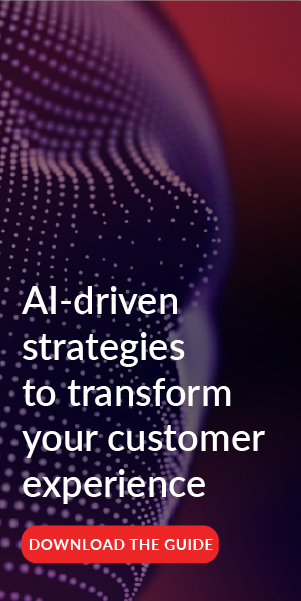Topics
Why 2025 is the year you’ll likely fire your traditional contact center vendor

If you haven’t implemented the right technologies into your contact center, you’re not the only one bothered. You may be fretting over lost opportunities for increased efficiency and better customer experiences.
Your customers, on the other hand, are likely bothered because they can’t easily have their issues solved on their own terms.
Traditional contact centers have relied on human agents and phone calls. And, they have often struggled with inconsistent service delivery and long, frustrating wait times. Customers are more dissatisfied than ever with contact centers that don’t employ the tech to make the experience frictionless.
Companies that don’t adapt to rising customer expectations risk losing business to their competitors who are embracing advanced technologies to augment the work of their call center agents.
Business Insider highlights this in an article about Bank of America’s response times during the COVID-19 pandemic. Customers reported long wait times when contacting the call center and difficulty accessing support for urgent banking needs. The bank's failure to adapt to a surge in inquiries led to widespread dissatisfaction, with many customers sharing their experiences online.
This is only an example of how traditional contact center vendors fail their customers. Many businesses weren’t ready for the challenges that 2020 would bring, and as a result the digital transformation of call center operations has been a top priority for many brands.
This has only accelerated with the widespread availability of generative AI technologies. Now almost five years post-pandemic, a surge in innovations makes it even more evident that it’s time for a change.
The old ways won’t work anymore
Eighty-eight percent of customers say the experience a company provides is as important as its products. Now more than ever, customers expect personalized and efficient service. They’re frustrated by long wait times, insufficient resolutions, and agents passing their problems back and forth between departments.
Traditional contact centers that use outdated practices may severely deteriorate customer satisfaction — and that can’t continue if you want good customer retention and growth.
Forrester’s 2023 US Customer Experience Index (CX Index) showed that customer perception of brand CX quality had dropped for the second consecutive year. The trend continued into 2024. Not only that, but research from Customer Management Practice (CMP) revealed that only 7% of consumers feel their experiences have improved over the past year, as opposed to 55% who feel their experiences have gotten worse.
This is a noticeable and alarming gap between expectations and actual service. But modern contact center partners are closing the gap by embracing the right mix of people, process and advanced technology. Their adaptability is delivering value to the bottom line and increasing customer satisfaction.
That’s why 2025 is likely the year that old-school business process outsourcers are likely to be put on notice.
How to stay ahead of the game
Brands are increasingly insisting that their partners have an innovation plan that continuously improves service delivery while also driving down costs and inefficiency.
Modern contact centers use AI, chatbots, and omnichannel support, which enables seamless switching between channels. They aim to provide more efficient services. These technologies allow for faster response times and more effective customer issue resolutions. Brands who are modernizing their approaches are seeing incredible success.
For example, McKinsey reports that “a leading telco was able to eliminate 50 percent of unnecessary service calls and inbound calls related to repairs by using robotics to proactively contact customers and resolve issues as soon as remote monitoring detected a malfunction.”
Another success story comes from DoorDash, who built a GenAI contact center and saw some serious results:
- 50x increase in testing capacity
- 50% reduction in response latency
- 100,000+ calls per day fielded by GenAI
The goal isn’t to have AI and other tech replace human-led CX. It’s to marry the two into a structure that balances efficiency and resource management with emotional intelligence and respect for data privacy.
Too many brands and BPO partners hesitate to invest in now readily available, scalable, and reliable technology tools due to budget constraints. Yet this reluctance comes at a cost — valuable time and other resources, the reputation they worked hard to cultivate, and ultimately... customer loyalty.
To this point on wasted resources, Harvard Business Review discusses another significant pain point that can be quickly resolved with tech-driven solutions: excessive customer effort. They note that “22% of repeat calls involve downstream issues related to the problem that prompted the original call, even if that problem itself was adequately addressed the first time around.”
Call centers can't resolve these issues without the correct data or tools. This creates a complicated backend system that human agents don’t always have the time or resources to manage. Technology can reduce this complexity, resulting in faster, more intelligent solutions.
BPO winners and losers...
The modern customer prefers self-service options and faster resolutions, but not all customers are the same. Generational and cultural differences must be considered. Still, the outdated workflows of traditional CX models are leaving customers frustrated. We’ve identified five things that frustrate customers during their interactions:
- repeating information, especially when switching channels
- how long it takes for a response
- how long it takes for a resolution
- a lack of quality service across channels
- a lack of visibility into the CX process
Modern contact center partners are addressing these concerns by dedicating budgets to innovation and adopting new technologies that can make them more valuable to their brand clients. The best of breed do this rigorously and are unafraid to disrupt their own commercial arrangements to chart a better path that alters the mix of people and tech. For this reason, the BPO space is undergoing major reconstruction.
Adrian Swinscoe writes about this consolidation for Forbes, based on a conversation with CGS’s Catherine Joost, President of the Business Process Outsourcing Division, and John Samuel, COO: “The first trend is the emergence of demand for next-generation services from outsourcers in areas like generative AI, robotic process automation, process modeling, data science and cyber security. The second trend is the geographic and linguistic diversity needed by global and fast-growing brands, and the third trend is the rising demand for the outsourcing of increasingly complex services.”
There are two ways to handle CX in the future. You can use models that focus on putting out fires instead of preventing them. Or you can invest in future-facing approaches so customer needs are anticipated before they metastasize into frustrations.
Is 2025 the year that you’ll make a change?
The competition between brands is getting more intense by the second. If you aren’t ahead, you’re behind.
The old way of doing things no longer serves your customers. It’s time to move away from traditional contact center models and select a modern partner who shares your brand’s values and is aligned to your goals and objectives. This necessarily means that your BPO partner must put your business's needs ahead of their own full time equivalents (FTEs) and commercial models.
With the right partner, the right commercial structures and shared objectives, and importantly... a joint commitment to continuous innovation, you’ll see improved customer satisfaction, efficiency, and adaptability. Now’s the time to reevaluate your contact centers to ensure all elements of your strategy and relationships are future-facing.


